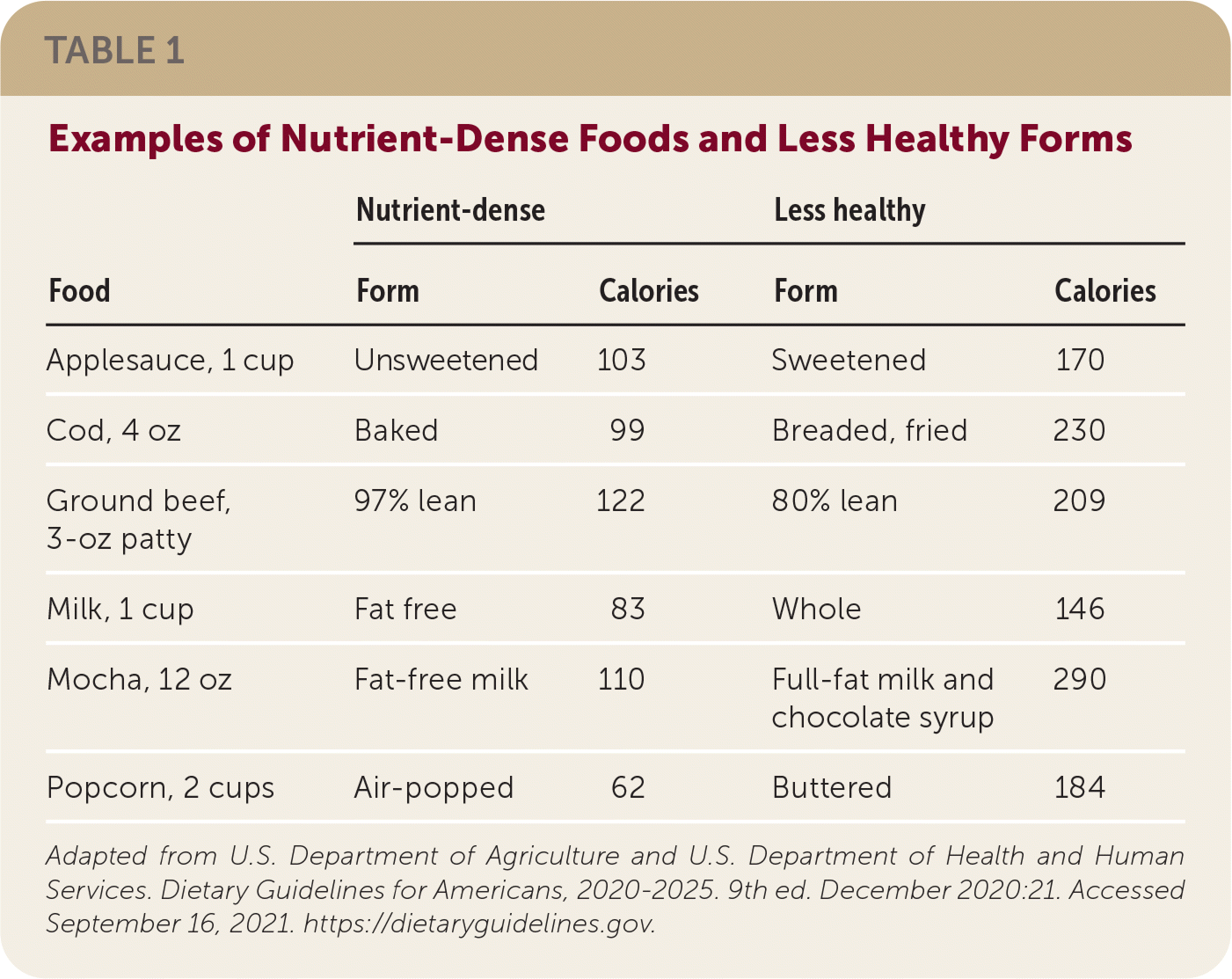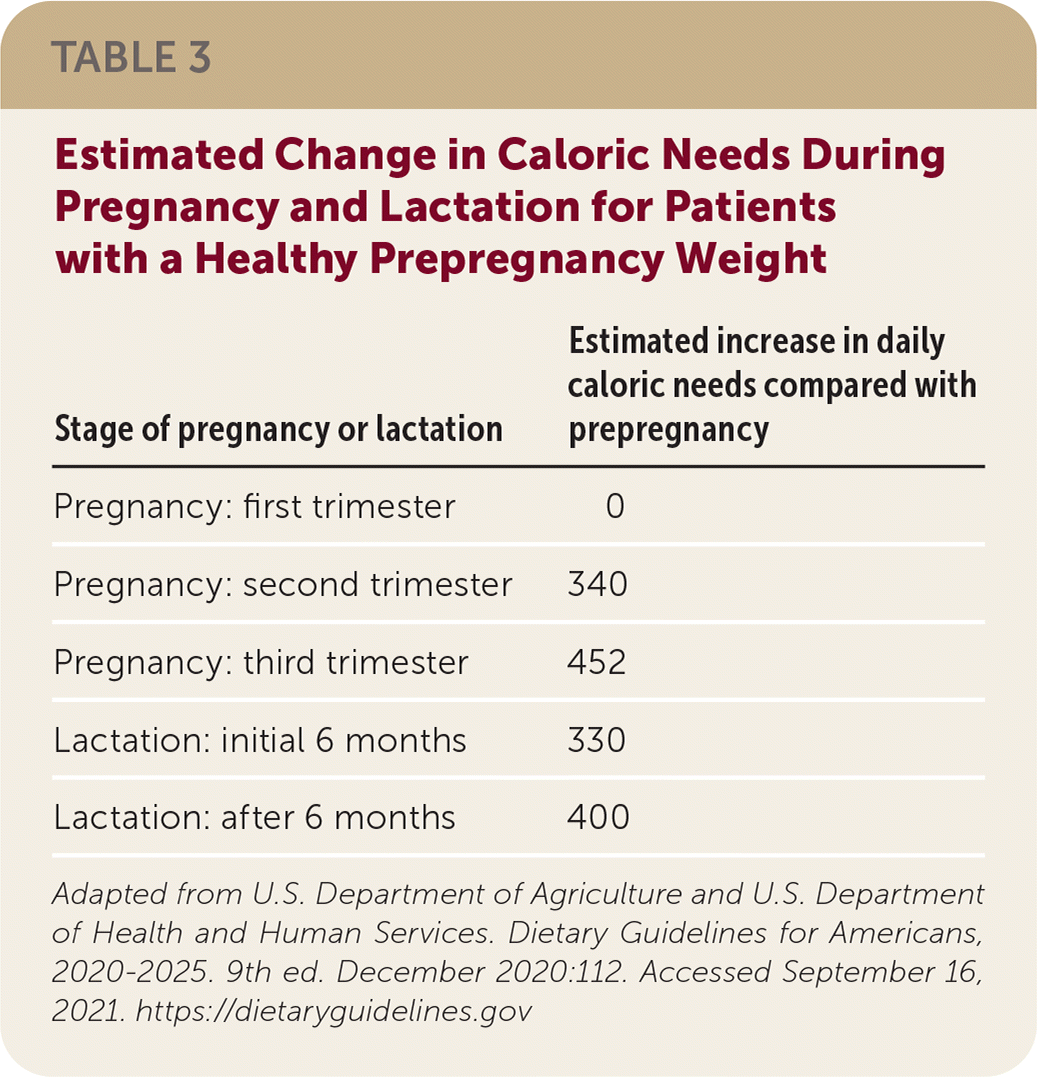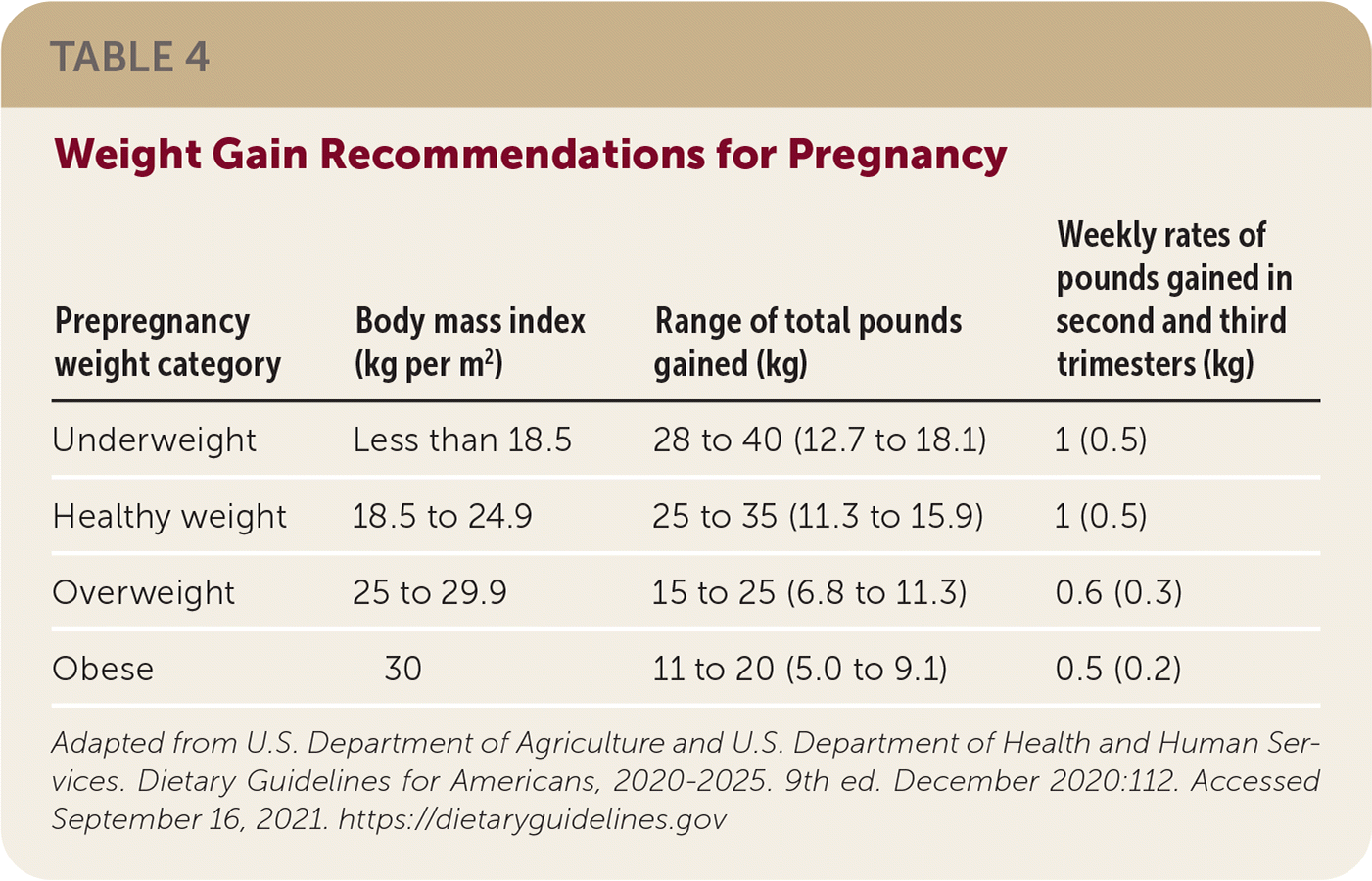
Am Fam Physician. 2021;104(5):533-536
Related editorial: Translating the 2020-2025 U.S. Dietary Guidelines into Clinical Practice
Author disclosure: No relevant financial affiliations.
Key Points for Practice
• For people two years and older, vegetables and whole fruits represent one-half of a healthy diet.
• Potentially allergenic foods should be introduced to infants at about six months of age with solid foods to reduce food allergies.
• During pregnancy, there is no need to limit potentially allergenic foods without a known food allergy, although large fish, unpasteurized juices and dairy products, and alcohol should be avoided.
• In older adults, high-protein diets can limit natural decreases in lean muscle mass and vitamin B12 deficiency caused by decreased absorption.
From the AFP Editors
More than one-half of U.S. adults have at least one diet-related chronic disease such as type 2 diabetes mellitus, cardiovascular disease, and some cancers. About three-fourths are overweight or obese. Foods are consumed in patterns, and it is these dietary patterns that affect disease risk. Because surveys show minimal improvement in healthy eating over the past 10 years, simple guidance is needed in improving food and beverage choices. The U.S. Departments of Agriculture and Health and Human Services published updated guidelines for healthy eating across a person's lifespan.
Core Dietary Elements
For people two years and older, healthy dietary patterns involve choosing nutrient-dense foods and beverages. Nutrient-dense foods provide vitamins, minerals, and other essential nutrients, and are lower in added sugar, saturated fat, and sodium (Table 1). At least one-half of food eaten should be fruits and vegetables, especially whole fruits and vegetables of a variety of colors. The core elements of the other half of food that should be eaten include grains, dairy, protein, and oils with lower saturated fat. At least one-half of grain servings should be whole grains. Minimize alcohol use and consumption of foods with added sugar, saturated fat, and sodium. Serving sizes on labels can be used to determine appropriate single portions.

| Food | Nutrient-dense | Less healthy | ||
|---|---|---|---|---|
| Form | Calories | Form | Calories | |
| Applesauce, 1 cup | Unsweetened | 103 | Sweetened | 170 |
| Cod, 4 oz | Baked | 99 | Breaded, fried | 230 |
| Ground beef, 3-oz patty | 97% lean | 122 | 80% lean | 209 |
| Milk, 1 cup | Fat free | 83 | Whole | 146 |
| Mocha, 12 oz | Fat-free milk | 110 | Full-fat milk and chocolate syrup | 290 |
| Popcorn, 2 cups | Air-popped | 62 | Buttered | 184 |
These guidelines will be more difficult to follow for people with food insecurity, which is the limited or uncertain access to nutrient-dense foods that affects 10% of households. Most people, even those without limited access, exceed the recommended intake of refined grains, added sugars, sodium, and saturated fats.
Infants and Toddlers
During the first four months of life, breast milk is the optimal sole form of nutrition. Infants fed breast milk as part or all of their diet should get a 400-IU supplement of vitamin D each day. An iron-fortified commercial infant formula is recommended when breast milk is unavailable. Formula should be prepared per the manufacturer's instructions.
Between four and six months of age, infants can begin eating nutrient-dense foods prepared to reduce choking risk. Although dairy products such as yogurt and cheese can be introduced at this time, cow's milk is not a safe replacement for human milk or formula until 12 months of age. Foods high in added sugar or sodium should be limited. Honey and unpasteurized foods (e.g., juices, milk, yogurt, cheeses) are unsafe for infants to consume.
Potentially allergenic foods such as peanuts, tree nuts, egg, soy, and shellfish should be introduced with other complementary foods at six months of age to reduce risk of allergy. There is no evidence that delaying introduction of allergenic foods prevents food allergy, and introducing peanut-containing foods in the first year reduces the risk of developing an allergy.
Children and Adolescents
The same core nutrient-dense foods are recommended for children and adolescents as for adults, because childhood habits guide adult eating patterns. Modeling and supporting healthy dietary patterns during childhood is the best way for parents and caregivers to prevent chronic diseases during adolescence and adulthood. Age-based caloric needs (Table 2) are estimates that should be adjusted by the size and activity level of the child. In childhood, beverages are optimally limited to water, unsweetened reduced fat milk, and juices without added sugars. Cow's milk should be fat free or reduced fat, although lactose-free or soy milk is also acceptable. Sugar-sweetened beverages such as soda, sports drinks, and energy drinks should be avoided.

| Life stage | Female caloric needs (kcal) | Male caloric needs (kcal) |
|---|---|---|
| Early childhood (2 to 4 years of age) | 1,000 to 1,400 | 1,000 to 1,600 |
| School age (5 to 8 years of age) | 1,200 to 1,800 | 1,200 to 2,000 |
| Late childhood (9 to 13 years of age) | 1,400 to 2,200 | 1,600 to 2,600 |
| Adolescence (14 to 18 years of age) | 1,800 to 2,400 | 2,000 to 3,200 |
| Adulthood (19 to 59 years of age) | 1,600 to 2,400 | 2,200 to 3,000 |
| Older adults (60 years and older) | 1,600 to 2,000 | 2,000 to 2,600 |
Adults
The core dietary elements also guide the adult diet. Standard caloric recommendations (Table 2) can be adjusted by age, activity, and current weight. U.S. adults consistently overconsume added sugars, refined grains, saturated fats, and sodium. Adults should be encouraged to prepare household meals from fresh ingredients, minimizing intake of sugar-sweetened beverages, alcohol, and added sugars. Sandwiches and grain-based dishes such as spaghetti and meatballs are the major sources of saturated fat in the U.S. diet. Increasing dietary fiber intake is particularly important to prevent coronary heart disease. Intake of calcium and vitamin D is particularly important in adults up to 30 years of age because bone mass is actively increasing.
Pregnancy and Lactation
Although caloric requirements increase during pregnancy and lactation (Table 3), many patients experience excessive weight gain during pregnancy. One-half of patients retain at least 10 lb (4.5 kg) of excess weight after pregnancy and one-fourth retain at least 20 lb (9.1 kg). Goal weight gain during pregnancy depends on starting weight (Table 4).

| Stage of pregnancy or lactation | Estimated increase in daily caloric needs compared with prepregnancy |
|---|---|
| Pregnancy: first trimester | 0 |
| Pregnancy: second trimester | 340 |
| Pregnancy: third trimester | 452 |
| Lactation: initial 6 months | 330 |
| Lactation: after 6 months | 400 |

| Prepregnancy weight category | Body mass index (kg per m2) | Range of total pounds gained (kg) | Weekly rates of pounds gained in second and third trimesters (kg) |
|---|---|---|---|
| Underweight | Less than 18.5 | 28 to 40 (12.7 to 18.1) | 1 (0.5) |
| Healthy weight | 18.5 to 24.9 | 25 to 35 (11.3 to 15.9) | 1 (0.5) |
| Overweight | 25 to 29.9 | 15 to 25 (6.8 to 11.3) | 0.6 (0.3) |
| Obese | 30 | 11 to 20 (5.0 to 9.1) | 0.5 (0.2) |
Potentially allergenic foods do not need to be restricted when pregnant or breastfeeding because they do not influence allergy development in children. Because pregnant patients are more susceptible to foodborne illnesses, proper washing and sufficient reheating of food are essential. Unpasteurized (raw) juice or milk, raw sprouts, or soft cheeses made from unpasteurized milk should be avoided. Access to healthy, safe food for children and families is a U.S. government priority. Families facing food insecurity should be referred to assistance programs such as the Special Supplemental Nutrition Program for Women, Infants, and Children to ensure adequate nutrition is available.
Although the guidelines contain minimal discussion of micronutrients, there are some recommendations for people who are planning to become pregnant or who are not effectively preventing pregnancy. One of the most important is the recommendation to consume 400 to 800 mcg of folic acid daily to reduce risk of neural tube defects. Another is to increase iron intake during pregnancy. Heme iron from animal sources is better absorbed than non-heme iron found in supplements and vegetables. For patients following vegetarian or plant-based diets, absorption of non-heme iron can be enhanced by consuming foods high in vitamin C. Seafood intake during pregnancy is associated with improved cognitive development in young children. However, large fish like tuna, king mackerel, and swordfish should be avoided to limit methylmercury ingestion and accumulation.
Although patients who are pregnant or planning to become pregnant should avoid alcohol, one in 10 drink an average of two alcoholic drinks in a day. When breastfeeding, avoiding alcohol is safest but one standard drink per day does not appear to harm the breastfed infant. Similarly, caffeine consumption of less than 300 mg daily during pregnancy and lactation does not appear to affect infant health.
Older Adults
Although core dietary elements do not change in older age, calorie requirements generally decrease. On average, older adults have the best quality diets. Consuming higher amounts of protein can limit the natural decrease in lean muscle mass. High-protein animal products and foods fortified with vitamin B12 such as cereals can decrease the risk of vitamin B12 deficiency from age-related decreases in absorption. Healthy eating recommendations for older adults may require adjustment based on ability to obtain and prepare food and ability to chew or swallow.
Consumption of water and unsweetened beverages is more important in older adults to maintain hydration, because bladder control, mobility changes, and diminishing thirst sensation increase risk of dehydration.
Editor's Note: Providing nutritional guidance can be challenging in the clinic. Although I try to tailor recommendations to my patients, I am often disappointed by the vague platitudes I hear myself saying. I hope that like me, you find some interesting information from these guidelines to add specificity to patient discussions.—Michael J. Arnold, MD, Contributing Editor
The views expressed are those of the author and do not necessarily reflect the official policy or position of the Department of the Navy, Uniformed Services University of the Health Sciences, Department of Defense, or the U.S. government.
Guideline source: U.S. Departments of Agriculture and Health and Human Services
Evidence rating system used? No
Systematic literature search described? No
Guideline developed by participants without relevant financial ties to industry? Yes
Recommendations based on patient-oriented outcomes? Yes
